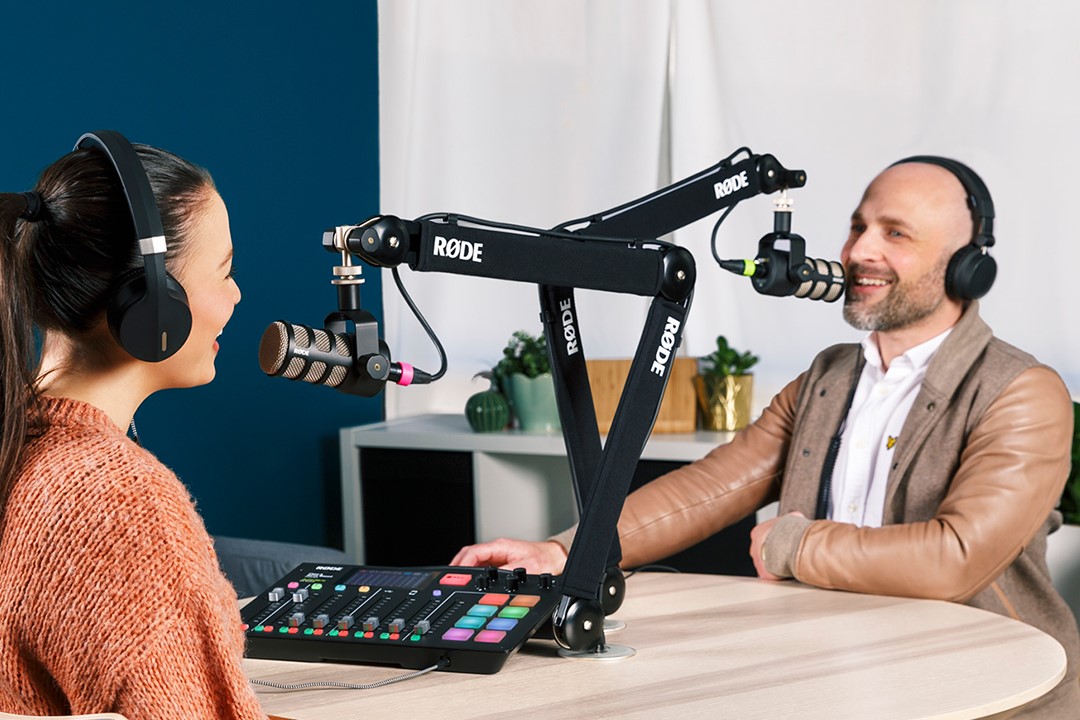Most dynamic mics want more gain. What you need with the PodMic depends on your location and setup. Since it doesn’t offer built-in amp circuits, the output is relatively low. You’ll want around -6 dB for podcasting with this microphone.
Keeping levels at -6 dB ensures that your tracks don’t peak while keeping the speech audible during a recording. If you crank the signal too much, the noise from your preamps could potentially interfere with your show.
The RØDE PodMic is a dynamic microphone with XLR connectivity, making it similar to the Procaster in its initial setup. You receive a built-in pop filter and a shock mount with the design, ensuring that it picks up less environmental noise. In return for those benefits, you’ll need more gain from the interface.
Related: Top Audio Interfaces For The RODE PodMic + Tips For Better Sound Quality
Contents
Do I Need to Use a Cloudlifter with the PodMic?
When you add the Cloudlifter to your setup, you get a box that turns 48V of phantom power into 20 dB of usable gain.
That option might be necessary for Shure microphones and some entry-level options, but the PodMic does a decent job without it. Although the sensitivity of the RØDE design is purposeful, the microphone delivers about 7 decibels more than competitive brands.
Related: Shure SM7B vs Rode PodMic. Which is a Better Podcasting Mic?
Is There USB Support for the RØDE PodMic?

Using PodMic for podcast recording. Image Source.
The RØDE PodMic is an XLR microphone. It requires you to invest in a digital recorder or an audio interface to capture your vocals. It’s specifically designed to work with the brand’s other products so that you can record and mix podcasts from one place.
It is tailored to vocals, so it captures speech better than most XLR microphones. It delivers excellent voice nuance, especially if you have a studio for your podcasts. It offers a lower noise floor and an advantageous directional pickup to keep the recording clean.
Unless you’re recording in a tiled room, the PodMic rejects off-axis noise to ensure you sound professional.
Do I Need to Use a Pop Filter with the PodMic?
The RØDE PodMic comes with an integrated pop filter to manage common plosives in podcasting.
Since it is designed for speech, the mesh grille and filter provide an above-average result for most recordings. It uses an enclosed capsule that delivers crispness and consistent outcomes.
You can use a separate pop filter if you want extra smoothness in your vocal delivery. Most get removed, but you may have some extra work to do in post-production. You might lose some of the top end from your mix with the additional filtration.
Related: Do I Need a Pop Filter for the Rode PodMic?
How Flexible Is the RØDE PodMic to Use?
Since the RØDE PodMic delivers excellent off-axis rejection and lacks sensitivity, you can capture clean and separate audio from multiple microphone placements in the same room. This advantage cannot be overstated if you record with others in the same studio or room.
The pickup pattern for the PodMic is cardioid instead of hypercardioid. You can be 20 degrees off-axis without having your tone encounter dramatic changes. That gives people who tend to move when speaking a more consistent podcast.
You’ll notice that the bass starts falling away from your voice after moving a couple of inches away from the microphone. If you want a booming sound, the setup requirements could be a little uncomfortable for some users.
Related: How to Set Up a Bedroom Recording Studio + Ideas
Shielding Is Necessary for the PodMic
Most podcasters record directly into a computer because of how convenient that setup is today. That means numerous electrical devices are nearby when you’re working on an episode for your show.
There is a bit of high-frequency interference that comes from the PodMic in this situation. If you use the RØDECaster with this microphone, you can change the harmonics and alter the mix to give your voice the tone and quality you prefer. That option is also available through most DAW installs.
It helps to be conservative with harmonic exciters. When you get it right, the results are better than standard EQ, but everything can go wrong quickly if you’re unsure of what you are doing.
Is the RØDE PodMic Worth Using?
With minimal gain requirements compared to other microphones in its class, the RØDE PodMic is an affordable solution that delivers impressive results.
It provides outstanding off-axis rejection while giving you production-ready audio. Those features are paired with a rugged housing that gives you confidence in its performance.
Anyone who wants to start podcasting or is thinking about an upgrade to their microphone should consider the PodMic. It delivers results.
Related: The Best Microphones For Recording in Podcasting (2023)